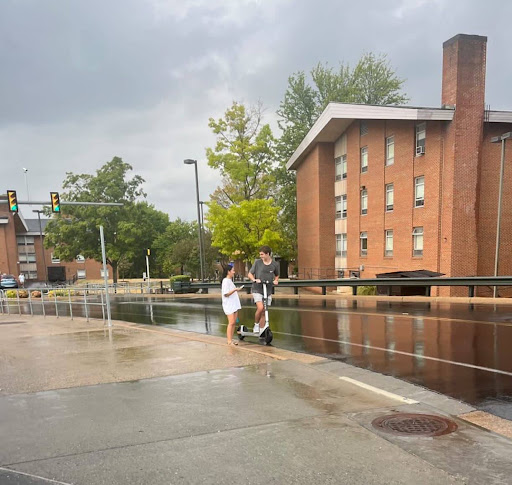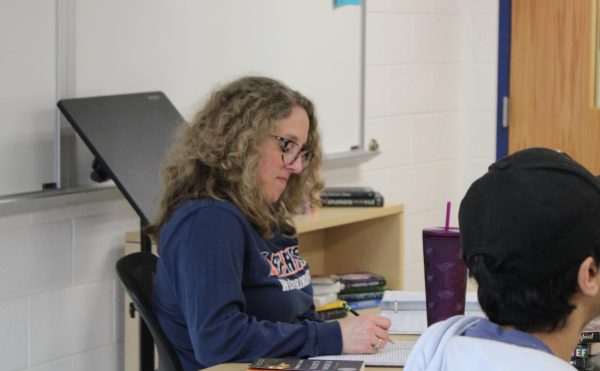Eco-anxiety and students: a dreadful duo

Photo courtesy of Christina Nies
Fall leaf colors of red, orange, and yellow finally revealed themselves in November. Compared to past years where the leaves started to change in October and September, this autumnal tradition arrived late.
Irregularly high temperatures and extreme weather conditions haven’t been the only things making students sweat.
Although climate change may seem like an issue thousands of miles and years away, the effects have begun to reveal themselves earlier this fall as temperatures soared to record highs of 80°F and extreme weather characterized Northern Virginia.
“Since the beginning of the school year, I’ve started to take notice of the unfamiliar weather,” said sophomore Katharine Nguyen. “September to me [is usually] the cooling month. Lower temperatures, a light jacket, and a slight breeze. Instead, I [was] sweating like it’s the middle of July in 90-degree weather.”
The transition from summer to fall was noticeably slow this year, which is supposed to be easily observed between September and October under normal conditions.
“[As of late October] the leaves have yet to turn fall colors, so it’s clear that the change in climate is happening,” said sophomore An-Nhien Bui.
In light of the looming threat of imminent disaster and irreversible environmental damage totted by the news cycle, a new term for people’s apprehension surrounding the crisis has been coined: eco-anxiety, or the “chronic fear of environmental doom.”
As climate change begins to close in on Northern Virginia, some students find that they aren’t immune to the psychological effects the change in weather brings.
“I do believe that the crisis has taken some toll on my well-being. I’m constantly worried about waking [up] to find any news reports stating the crisis’ impact, and [how] much time we have to fix it,” stated Nguyen.
In contrast, other students’ mental health remains uninfluenced.
“Frankly, it hasn’t affected me much,” said Bui. “I can say that, yes, it is a negative thing and it makes me want to strive for a better environment; however, it hasn’t had an effect on me personally.”
Greater focus on factors pertaining to day to day stressors was one reason cited for lack of concern.
“I try to ignore [climate change]. Also, I’m usually more concerned with classwork and grades,” explained sophomore Dana Glass.
Besides the general worry and dread surrounding the environment that classifies eco-anxiety, depressive symptoms such as hopelessness and grief can also be present. Feelings of anger, panic, guilt, and obsessive thoughts are also common.
“The climate crisis has given me a sense of hopelessness,” said Nguyen. “We went from week-long [school cancellations due to] snow days, to just an inch of snow once a year. It’s scary how fast our climate can impact us locally.”
In spite of the challenges presented by the crisis, students were still able to draw inspiration from a seemingly-hopeless dilemma.
“Why be hopeless when all has yet to be lost? We still have enough time and power to [prevent] it,” said Bui, showing how there is still a chance for our planet to be saved
This September, the Fairfax County Board of Supervisors began to take initiative to fight against the crisis by accepting a plan called the CECAP (County-wide Energy and Climate Action Plan). Main goals of the plan include Fairfax County becoming carbon neutral by 2050, which is to be achieved by ecoizing (specifically making more energy efficient) at least 10,000 housing units by 2030. Although the county is taking action, desires for implementing climate change education in schools is a more significant concern for Spartans.
“The county should create more opportunities for students to express themselves, more community service opportunities that could be advertised at school, and possibly educating students (other than the same videos they show us every year) about [climate change] and current issues that are important,” explained Bui.
Despite differences in immediate concern for the fate of the planet, one attitude was held unanimously among students.
“We only have a few more chances to set this straight,” stressed Nguyen. “Our earth is dying, and if we don’t do anything about it, there will be irreversible consequences.”





